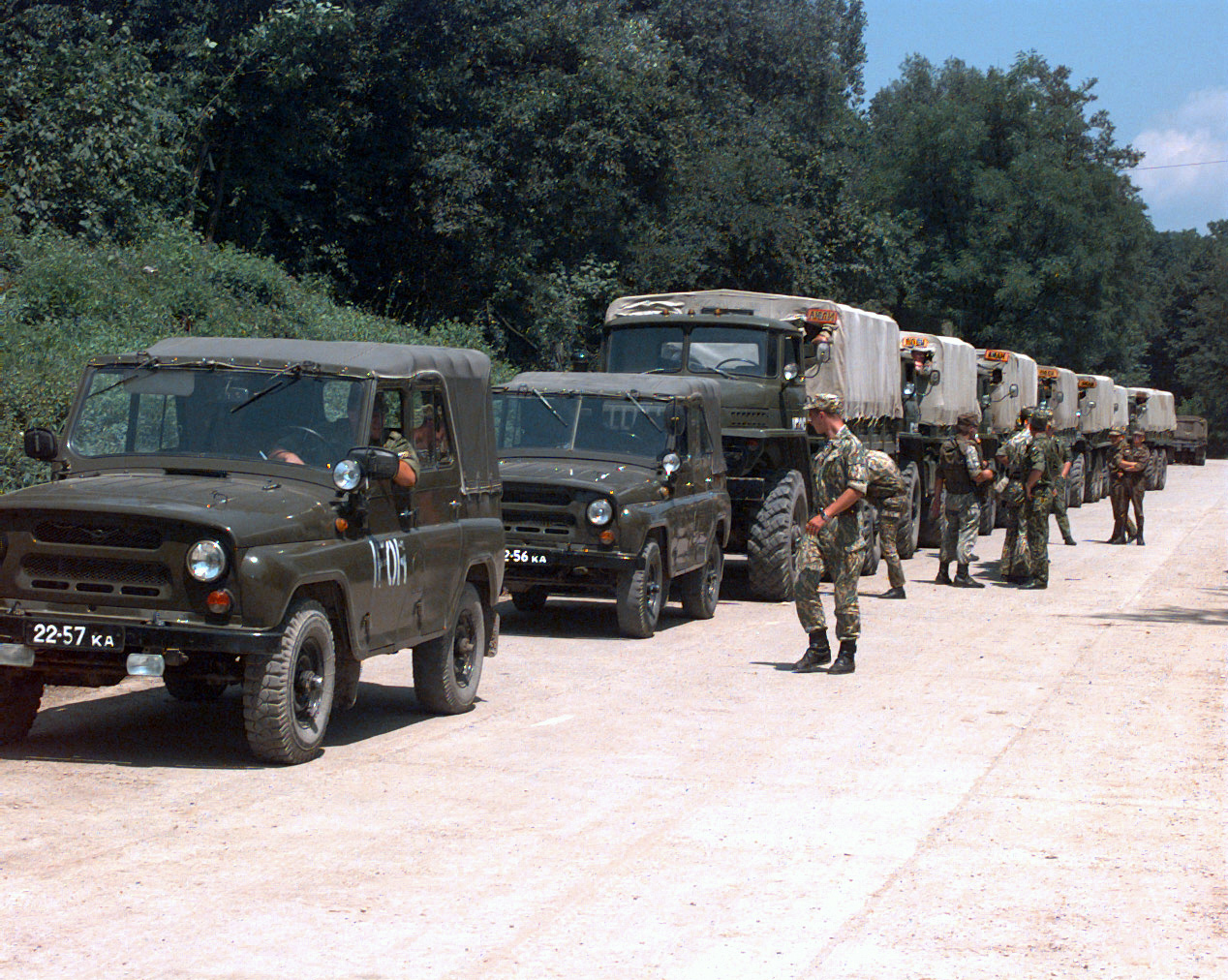The Unholy Trinity of Corruption, Low Morale, and Military Failure
There is an extreme difference in the morale of the Ukrainian troops as compared to the Russian troops, one that is worth noting and is best understood in a historical context.

Published by The Lawfare Institute
in Cooperation With

The Russian invasion of Ukraine and the ongoing war provide even more evidence of an army steadily losing ground because of a toxic combination of abysmal morale and corruption throughout the ranks. The tight coupling of corruption, low morale, and military failure has played out several times since World War II—in Cuba, in Vietnam, in Iraq, and in Afghanistan, to name a few. Policymakers would do well to pay attention.
I learned about the importance of morale in Vietnam when I investigated fragging, an internecine conflict in which troops turn on their superiors (the word “fragging” refers to fragmentation grenades, the weapons of choice when enlisted men try to kill their superiors). I explore fragging and morale in more depth in an article about my investigation published by the Saturday Review on Jan. 8, 1972, entitled, "The Demoralization of an Army: Fragging and Other Withdrawal Symptoms." In Vietnam, fraggings soared because American forces consisted largely of a draft army whose conscripts didn’t understand the mission, and who could see they were risking their lives for a corrupt regime whose own troops were reluctant to fight. By contrast, the Viet Cong and North Vietnamese troops fought with messianic fervor.
The fraggings in Vietnam provide a not-so-distant mirror (to borrow Barbara Tuchman’s phrase) on what is now going on in Ukraine. There are numerous parallels (as well as differences) between fraggings in Vietnam and those afflicting the Russian army in Ukraine 50 years later. One striking parallel in particular offers a lesson for both policymakers and military strategists.
One of the mysteries of fraggings in Vietnam was that many took place in the rear echelons, far removed from the risks of the front lines. From my reporting, I found several tributaries to this rear echelon violence, including the erosion of a sense of mission as the war dragged on, racial tensions, and drug use. One trend in particular stood out.
By the end of the war, the demographics of the troops had changed dramatically. In the early years of the war, the draft was relatively democratic, sweeping up the well-off and the poor, the highly educated and the dropouts. This changed over the course of the war. By 1971, for instance, most college graduates could work the system to avoid the front lines, if not the draft, leaving the ranks populated with the least articulate and most prone to act out frustrations through violence, not words. Unlike the draft army of World War II, if an aggrieved soldier said, “Let’s frag the sarge,” there might not be someone in the unit saying, “That’s murder.”
This is not to say that the better educated are morally superior; rather, this information shows that a unit that draws from a diversity of backgrounds will also have a diversity of opinions and is less likely to resort to extreme, rash action. If a unit is composed of soldiers drawn from a variety of backgrounds, it turns out to be less likely that the rest of the unit will go along when one soldier proposes blowing up an officer because they hadn’t had a shower in a week (this happened!).
Similarly, in Russia today, a more dramatic version of this natural selection of the resentful and powerless filling the lower ranks is playing out. To be sure, some element of low morale has to do with the dubious premises of the invasion. But the composition of the ranks echoes the demographics of the U.S. foot soldiers toward the end of the Vietnam War.
Hundreds of thousands of eligible Russian men have fled the country, and the elites and educated often have been able to avoid the mobilization that is dragging ordinary Russians into the war in Ukraine. The result is that the mobilization is disproportionately drawing from poorer, non-ethnic Russians from far-flung republics, many of whom do not see this as their fight.
So, once again, there are reports of fraggings, but only on the Russian side. Accounts of lower ranks killing their officers have been proliferating, including, most recently, when two (or perhaps three) troops undergoing training opened fire on their fellow trainees in a military facility in Belgorod, killing at least 11 (and maybe as many as 32) and wounding many more. As in Vietnam, the recently mobilized conscripts are being asked to risk their lives for a mission that seems to shift on a weekly basis. Reportedly, before the attack, the perpetrators had written to their commanders that “this is not our war,” though sourcing on this statement is minimal.
The striking parallel and useful takeaway for those who study the organization and hierarchies of armed forces is that, in both cases, a breakdown in a critical function of the noncommissioned officer corps contributed to the atmosphere in which fraggings occurred. In the U.S. army, the noncommissioned officers (NCOs) have a lot of functions, including mediating between the troops and the officers. They can be the eyes and ears for the officers and can serve as an early warning system if tensions are building. They can also head off internal acts of violence before they occur.
As the Vietnam conflict wore on, a yawning gap opened between the troops, the NCOs, and the officers. The NCOs were often lifers and were as alienated from their resentful draftees as the college-educated officers, and quite often the sergeants withdrew from all but necessary contact with their men. The result was that the officers were all but blind to resentments that might be boiling up, and the NCOs often weren’t there to head off trouble.
This issue was brought to my attention when I interviewed a soldier in Long Binh Jail (a famous military prison in Vietnam that was nicknamed LBJ) who was there because he had tried to blow up his commanding officer. I gave him the pseudonym of “Walt Ross.” Ross was a bland, even affable guy, and he’d tried to kill his commander because he was “irritated” (his word) that the commander kept volunteering his men to patrol outside the perimeter, and was depriving his soldiers of hot showers, decent meals, and other creature comforts. At 10 p.m. one night, Ross got together with other disgruntled troops and talked about “doing a job on the captain.” They all agreed. “Nobody said, ‘Don’t do it,’” Ross told me. His captain was lucky that Ross was so incompetent—he put three Claymore mines under the wrong armored truck and detonated them without hesitation. When I asked him how he would have felt if he’d blown up the officer, he said, “I’d have been tickled pink.”
In the Russian army, NCOs have strictly limited duties (with many of their functions taken up by the officer corps), and those duties are often more likely to sow distrust with the conscripts rather than reduce tensions. Often the Russian noncoms are instruments of brutality in the tradition of hazing called “dedovshchina” that dates back to before the Soviet army.
Fraggings point to the need for intermediaries but also the need for diversity in a conscript army. The American draft during World War II swept up everybody with a pulse, likely ensuring that every unit would have someone who would have said to Ross, “Don’t do it; that’s murder.” (To be sure, there have been battlefield fraggings throughout history.) The move to a volunteer army in the U.S. reduced one component of fraggings because the soldiers are choosing to be in the army. This is not an option for Russia today.
In fact, the Russian army has problems beyond relying on conscripts that make it likely that fraggings, desertions, and internal rebellions will continue and even proliferate.
Unlike American soldiers in Vietnam, Russian conscripts have to deal with incompetence, rampant corruption, and brutality in the command structure. Reports conclude that new conscripts have been rushed to the front lines with little or no training and haphazard equipment. Incredibly, there are reports that many have to buy their own body armor. Other reports from inside Russia speak of fake body armor, and that one and a half million uniforms needed for the oncoming winter have gone missing. And one reason that Russia didn’t have a Fifth column in place to support the invasion from inside Ukraine was that FSB (Federal Security Service) officials charged with greasing the palms of Ukrainian officials supposedly diverted much of the money to their own pockets.
It wasn’t supposed to be this way. Ukraine had a reputation as riven with corruption and the Russian army was supposed to be a formidable, well-disciplined fighting machine. Cynics expected that many of the HIMARS and other high-tech weapons that the West has delivered to Ukraine would end up on the black market or in Russian hands. That hasn’t happened. Quite the reverse: The Ukraine forces have been harvesting a bonanza of tanks, vehicles, and artillery left behind by retreating Russians who, often, haven’t disabled the weapons.
Ukraine does have a problem with corruption, but the Russian invasion seems to have activated a patriotic passion that, at least for now, seems to have trumped temptations to divert the war to private ends. Moreover, the Ukrainians have a plain-spoken, charismatic, and courageous leader, Volodymyr Zelenskyy, who has stayed to lead his country despite the omnipresent threat of death squads sent by Russia to kill him. Polling has shown that Zelenskyy’s approval rating has tripled to around 90 percent from before the invasion, when many saw him as a weak, ineffectual leader. Most of all, every Ukrainian, professional soldier or volunteer, knows why they are fighting, and the Russians provide helpful reminders every day by bombing civilian targets such as schools, hospitals, apartment buildings, and playgrounds.
By contrast, the Russian troops were not even told of the invasion until it took place and, once in Ukraine, they expected to be greeted as liberators. Testament to the lack of esprit de corps in the troops is that the retreating Russians have been leaving their dead behind. The obligation to leave no man or woman behind is fundamental to the spirit of any well-run army. Further, a disciplined army does not loot, murder, and rape civilians. There is, of course, a fog of propaganda around any war, but reports of Russian war crimes are too widespread and varied to be total fabrications.
“Character is destiny,” observed the philosopher Heraclitus some 2,500 years ago, but the lesson never seems to have been learned. Why Russian President Vladimir Putin decided to invade Ukraine remains open to debate, but he used a mixture of lies and coercion to justify the invasion and find the troops to do the work. He was either blind or indifferent to the corruption of his army and brutality of its leaders, not just to hapless civilians, but toward his army’s own troops. Now he’s paying the price for the rot that pervades every aspect of this invasion. The lies that were the basis of the invasion fell apart almost immediately once a soldier entered Ukraine. The entirely predictable result has been that the poorly trained, underequipped, badly led Russian army is losing on almost all fronts and is coming apart internally at the same time.
Unlike the U.S.’s experience with corrupt, incompetent allies during the Cuban revolution, as well as in Vietnam, Iraq, and Afghanistan, the U.S. now has a secret weapon on its side—the righteous fervor of the people it is trying to help. That’s a welcome change.





